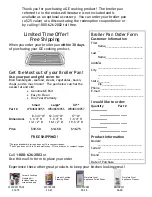
49-80804 Rev. 3
23
TROUBLESHOOTING TIPS
Troubleshooting Tips ...
Before you call for service
Save time and money! Review the charts on the following pages first and you may not need to call for service.
Problem
Possible Cause
What To Do
Surface units will not
maintain a rolling boil or
cooking is not fast enough
Improper cookware being used.
8VHSDQVZKLFKDUHIODWDQGPDWFKWKHGLDPHWHURIWKH
surface unit selected.
In some areas, the power (voltage) may be low.
Cover pan with a lid until desired heat is obtained.
Surface units do not work
properly
A fuse in your home may be blown or the circuit
breaker tripped.
Replace the fuse or reset the circuit breaker.
Cooktop controls improperly set.
Check to see the correct control is set for the surface
unit you are using.
Surface unit stops glowing
when turned to a lower
setting
The unit is still on and hot.
This is normal.
Scratches (may appear as
cracks) on cooktop glass
surface
Incorrect cleaning methods being used.
Scratches are not removable. Tiny scratches will become
less visible in time as a result of cleaning.
Cookware with rough bottoms being used or coarse
particles (salt or sand) were between the cookware
and the surface of the cooktop. Cookware has been
slid across the cooktop surface.
To avoid scratches, use the recommended cleaning
procedures. Make sure bottoms of cookware are clean
before use, and use cookware with smooth bottoms.
Areas of discoloration on
the cooktop
Food spillovers not cleaned before next use.
See the Cleaning the glass cooktop section.
Hot surface on a model with a light-colored cooktop.
This is normal. The surface may appear discolored when
it is hot. This is temporary and will disappear as the
glass cools.
Plastic melted to the
surface
Hot cooktop came into contact with plastic placed
on the hot cooktop.
See the Cleaning the glass cooktop section as there is
potential for permanent damage without proper care.
Pitting (or indentation) of
the cooktop
Hot sugar mixture spilled on the cooktop.
Call a qualified technician for replacement.
Frequent cycling off and on
of surface units
Improper cookware being used.
8VHRQO\IODWFRRNZDUHWRPLQLPL]HF\FOLQJ
My new oven doesn't
cook like my old one. Is
something wrong with the
temperature settings?
Your new oven has a different cooking system from
your old oven and therefore may cook differently
than your old oven.
For the first few uses, follow your recipe times and
temperatures carefully. If you still think your new oven is
too hot or too cold, you can adjust the temperature yourself
by following the steps in Special Features to meet your
specific cooking preference.
NOTE:
This adjustment affects
Bake, and Convection Bake temperatures; it will not affect
Convection Roast, Broil or Clean.
Food does not bake
properly
Oven controls improperly set.
See the Cooking Modes section.
Rack position is incorrect or rack is not level.
See the Cooking Modes section and Cooking Guide.
Incorrect cookware or cookware of improper size
being used.
See the Cookware section.
Oven temperature needs adjustment.
See the Special Features section.
Ingredient substitution
Substituting ingredients can change the recipe outcome.
Food does not broil
properly
Oven controls improperly set.
Make sure you select the appropriate broil mode.
Improper rack position being used.
See Cooking Guide for rack location suggestions.
Food being cooked in a hot pan.
Make sure cookware is cool.
Cookware not suited for broiling.
8VHDSDQVSHFLILFDOO\GHVLJQHGIRUEURLOLQJ
Aluminum foil used on the broiling pan and grid has
not been fitted properly and slit as recommended.
If using aluminum foil conform to pan slits.
In some areas the power (voltage) may be low.
Preheat the broil element for 10 minutes.
Oven temperature too hot
or too cold
Oven temperature needs adjustment.
See the Special Features section.













































